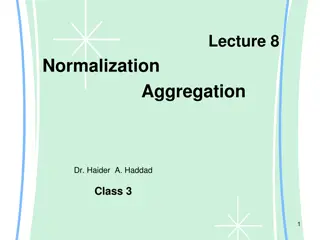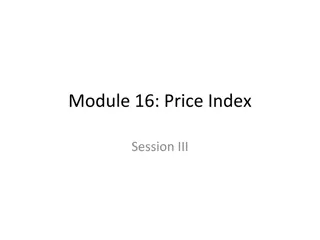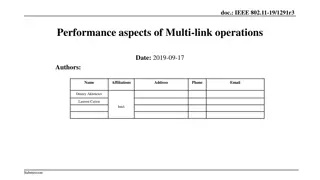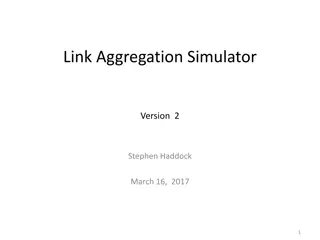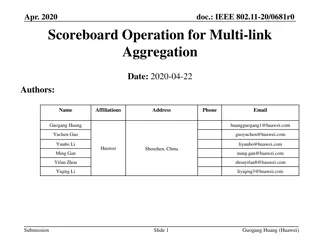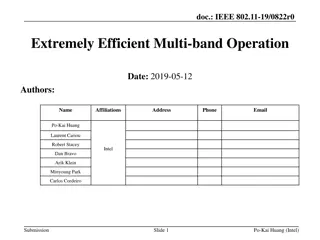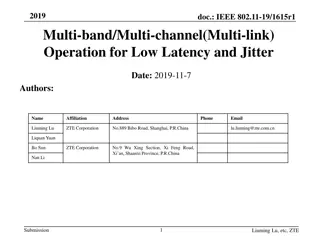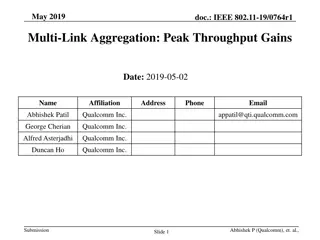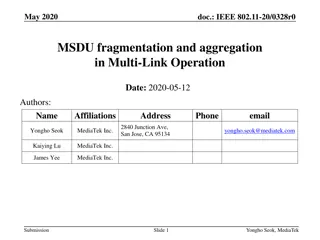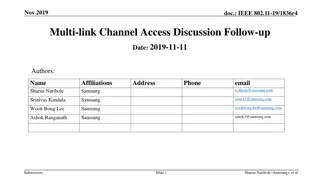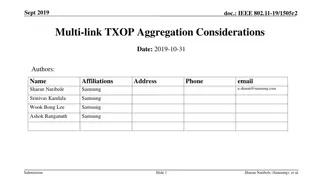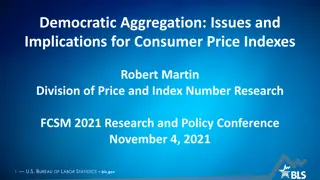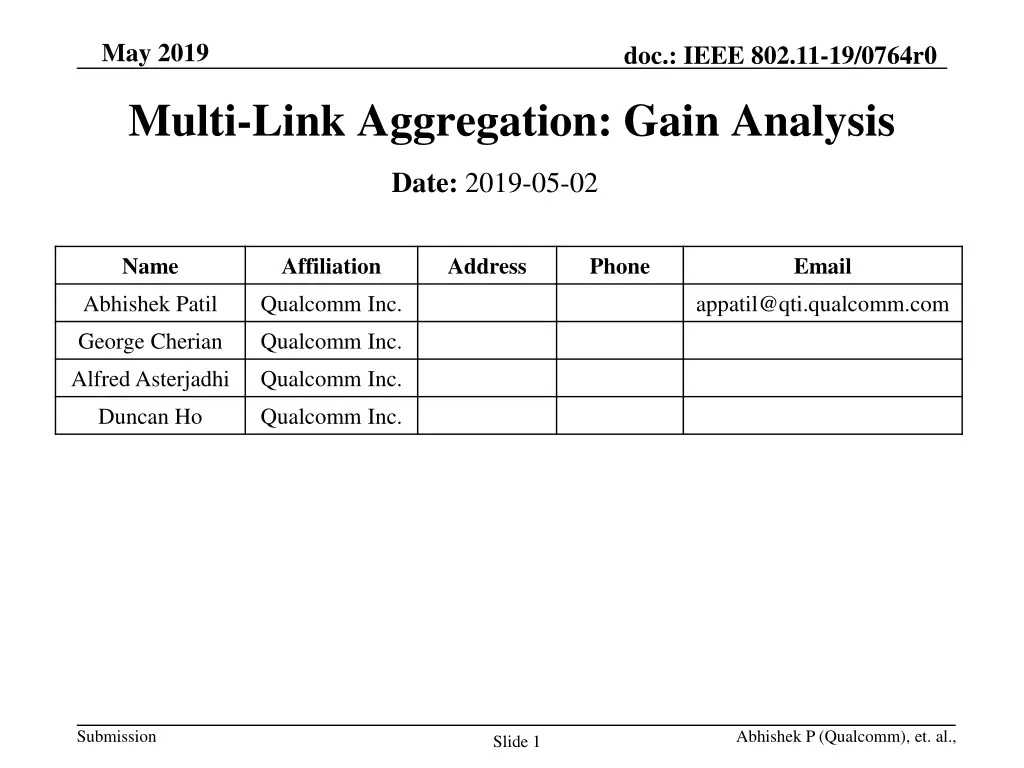
Gain Analysis of Multi-Link Aggregation for IEEE 802.11-19/0764r0
Explore the benefits and motivation behind Multi-Link Aggregation (MLA) in IEEE 802.11-19/0764r0 standard. Learn how MLA improves throughput, latency, and spectral efficiency by utilizing multiple links for data transmission. Gain insights from simulations comparing different aggregation schemes to enhance network performance.
Download Presentation

Please find below an Image/Link to download the presentation.
The content on the website is provided AS IS for your information and personal use only. It may not be sold, licensed, or shared on other websites without obtaining consent from the author. If you encounter any issues during the download, it is possible that the publisher has removed the file from their server.
You are allowed to download the files provided on this website for personal or commercial use, subject to the condition that they are used lawfully. All files are the property of their respective owners.
The content on the website is provided AS IS for your information and personal use only. It may not be sold, licensed, or shared on other websites without obtaining consent from the author.
E N D
Presentation Transcript
May 2019 doc.: IEEE 802.11-19/0764r0 Multi-Link Aggregation: Gain Analysis Date: 2019-05-02 Name Affiliation Address Phone Email Abhishek Patil Qualcomm Inc. appatil@qti.qualcomm.com George Cherian Qualcomm Inc. Alfred Asterjadhi Qualcomm Inc. Duncan Ho Qualcomm Inc. Submission Abhishek P (Qualcomm), et. al., Slide 1
May 2019 doc.: IEEE 802.11-19/0764r0 Motivation for Multi-Link Aggregation (MLA) New devices are expected to be multi-band/multi-channel capable Trend to grow, with 6 GHz band support STA 1 Same flow on both links Benefits of Multi-band/channel (MLA) Increased peak throughput Packets of the same flow can be sent over multiple links Channel diversity helps to smoothen out the data flow during link fluctuations Helps quickly flush out per-user queues Increased spectral efficiency Packets from a high-volume link can be multiplexed on an under-utilized link Smooth transition between multiple radios Enables framework for a control channel/data channel separation Link 1 Link 2 Emerging applications such as wireless-VR and interactive multi-player gaming would benefit from MLA Such applications have strict requirements such as low latency, short turnaround times and have burst traffic that need to be quickly flushed out. STA 2 Submission Slide 2 Abhishek P (Qualcomm), et. al.,
May 2019 doc.: IEEE 802.11-19/0764r0 Multi-Link Aggregation Benefits Increases peak throughput Improves latency Multi-Link Aggregation Single Link AP 2 AP 3 AP 1 T STA 1 AP 1 [Link 1] Link 1 [Link 1, 2, & 3] [Link 1, 2, & 3] [Link 1, 2, & 3] Moderate load ~T/3 X Mbps Aggregation Link 1 across links STA 2 ~3X Mbps AP 2 [Link 2] Link 2 Link 2 Moderate load Link 3 STA 1 STA 2 STA 3 AP 3 [Link 3] STA 3 Link 3 * Transmissions need not be aligned across multiple links. Shown here for simplicity Moderate load Time Time Submission Slide 3 Abhishek P (Qualcomm), et. al.,
May 2019 doc.: IEEE 802.11-19/0764r0 Gain Analysis Simulation Setup Traffic Model: full buffer DL AP has a very large file to DL to a single STA (full buffer case) All PPDUs transmitted at 480 Mbps (MCS9 @80MHz). TXOP: varies between 4-12ms Channel load is modeled by varying the number of full buffer OBSS contenders from 1-8 Total contenders = APUT + OBSS_1 Link 1 Single Link Total contenders = APUT + OBSS_1 Link 1 Gains are compared between the following schemes Baseline: No Aggregation (single link) Simultaneous mode EDCA back-off performed on single primary; ED check on secondary link before transmission Aggregated if 2nd link is idle. Otherwise, single transmission on primary link Independent mode EDCA back off & TXOP duration on each link are independent Total contenders = OBSS_2 Link 2 Simultaneous Mode Total contenders = APUT + OBSS_1 Link 1 Total contenders = APUT + OBSS_2 Link 2 Independent Mode AP contends for the medium Transmission from OBSS AP s transmission Gains are expressed as peak throughput Submission Slide 4 Abhishek P (Qualcomm), et. al.,
May 2019 doc.: IEEE 802.11-19/0764r0 Simulation Results Varying high load on both links Setup AP under test: Full buffer DL Channel load modeling: Both link 1 & link 2: Sweep of 2 to 8 OBSS STAs Link 1: Starts with 2 STAs, and 1 new STA is added every 100ms up to 8 STAs, and drops back to 2 STAs, and repeats Link 2: Starts with 8 STAs, and 1 STA is removed every 100ms until 2 STAs, and jumps back to 8 STAs, and repeats Observation Significantly higher 5%ile gains for independent mode operation because of higher opportunity to transmit due to independent channel access, than a simultaneous mode operation Agg Scheme 5%ile 50% 95% ile (Mbps/Gain-x) Independent mode (gains w.r.t baseline) 106.58 (2.81x) 168.75 (2.01x) 236.78 (1.70x) Simultaneous mode (gains w.r.t baseline) 44.55 (1.18) 97.69 (1.16x) 161.30 (1.16x) Baseline 37.87 83.97 139.29 Submission Slide 5 Abhishek P (Qualcomm), et. al.,
May 2019 doc.: IEEE 802.11-19/0764r0 Simulation Results High/medium loads on links Setup AP under test: Full buffer DL Channel load modeling: Link 1: Sweep of 2 to 8 OBSS STAs. Starts with 2 STAs, and 1 new STA is added every 100ms up to 8 STAs, and drops back to 2 STAs, and repeats Link 2: Sweep of 1 to 4 OBSS STAs. Starts with 1 STA, and 1 new STA is added every 200ms up to 4 STAs, and drops back to 1 STAs, and repeats Observation Most pronounced gains for independent mode compared to simultaneous mode Agg Scheme 5%ile 50% 95% ile Mbps (Gain-x) Independent mode (gains w.r.t baseline) 150.39 (3.96x) 214.25 (2.56x) 290.77 (2.10x) Simultaneous mode (gains w.r.t baseline) 46.93 (1.23x) 105.82 (1.27x) 175.16 (1.26x) Baseline 38.02 83.55 138.51 Submission Slide 6 Abhishek P (Qualcomm), et. al.,
May 2019 doc.: IEEE 802.11-19/0764r0 Summary In this contribution, we present the benefits of multi- link aggregation and present simulation results showing gains for two different aggregation schemes Submission Slide 7 Abhishek P (Qualcomm), et. al.,
May 2019 doc.: IEEE 802.11-19/0764r0 APPENDIX Submission Slide 8 Abhishek P (Qualcomm), et. al.,
May 2019 doc.: IEEE 802.11-19/0764r0 Simulation Results Fixed high / low load Setup AP under test: Full buffer DL Channel load modeling: Link 1: 8 OBSS STAs Link 2: 2 OBSS STAs Observation Significantly higher 5%ile and overall gains seen for independent mode operation because of higher opportunity coming from low-load link 2 Agg Scheme 5%ile 50% 95% ile (Mbps/Gain-x) Independent mode (gains w.r.t baseline) 135.44 (7.56x) 198.20 (4.13x) 269.33 (3.07x) Simultaneous mode (gains w.r.t baseline) 21.36 (1.19x) 63.83 (1.33x) 120.76 (1.37x) Baseline 21.36 63.83 120.76 Submission Slide 9 Abhishek P (Qualcomm), et. al.,
May 2019 doc.: IEEE 802.11-19/0764r0 Simulation Results Fixed high load on both links Setup AP under test: Full buffer DL Channel load modeling: Both link 1 & link 2 have 8 OBSS STAs Observation Pronounced gains for independent mode compared to simultaneous mode Agg Scheme 5%ile 50% 95% ile (Mbps/Gain-x) Independent mode (gains w.r.t baseline) 51.34 (3.05x) 98.29 (2.04x) 151.55 (1.70x) Simultaneous mode (gains w.r.t baseline) 18.63 (1.11x) 54.43 (1.13x) 101.68 (1.14x) Baseline 16.82 48.25 88.95 Submission Slide 10 Abhishek P (Qualcomm), et. al.,
May 2019 doc.: IEEE 802.11-19/0764r0 Simulation Results Fixed low load on both links Setup AP under test: Full buffer DL Channel load modeling: Both link 1 & link 2: 2 OBSS FB STAs Observation Higher 5%ile gains for independent mode operation because of higher opportunity to transmit due to independent channel access, than a simultaneous mode operation Agg Scheme 5%ile 50% 95% ile (Mbps/Gain-x) Independent mode (gains w.r.t baseline) 227.40 (2.3x) 300.19 (2.00x) 376.37 (1.85x) Simultaneous mode (gains w.r.t baseline) 122.65 (1.24x) 195.57 (1.30x) 272.61 (1.34x) Baseline 99.03 150.15 203.60 Submission Slide 11 Abhishek P (Qualcomm), et. al.,

